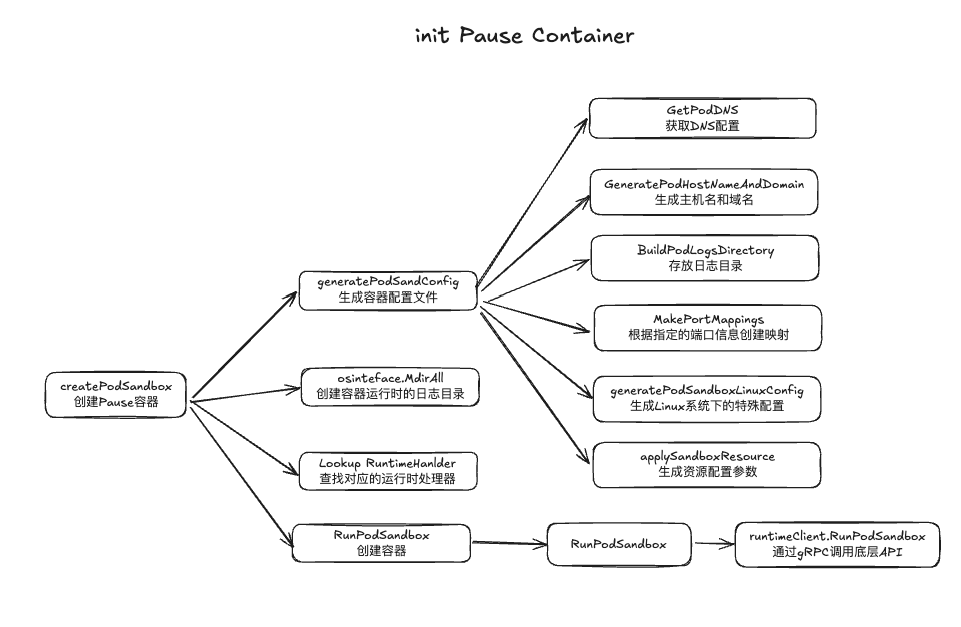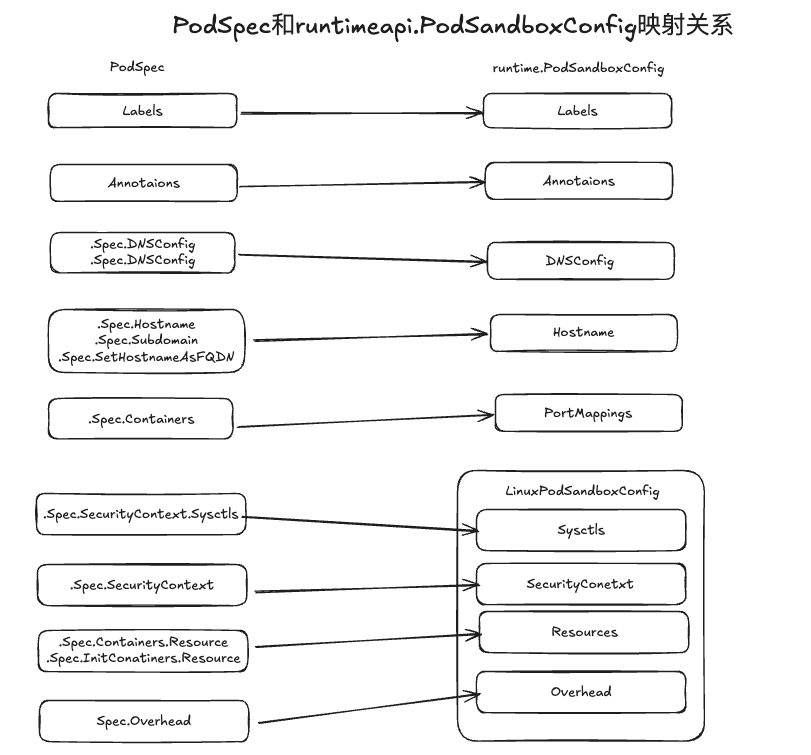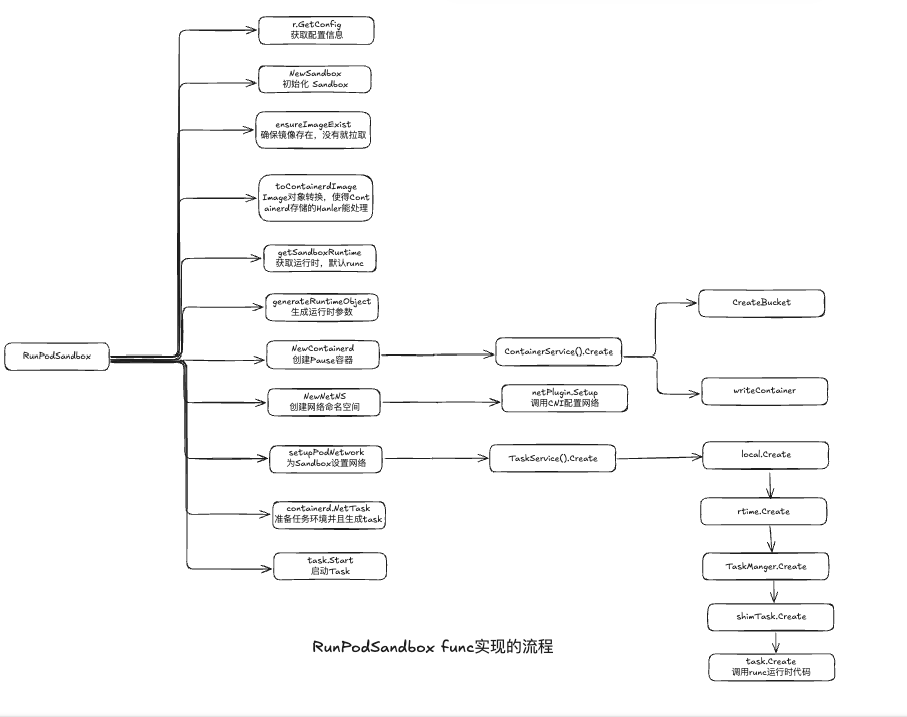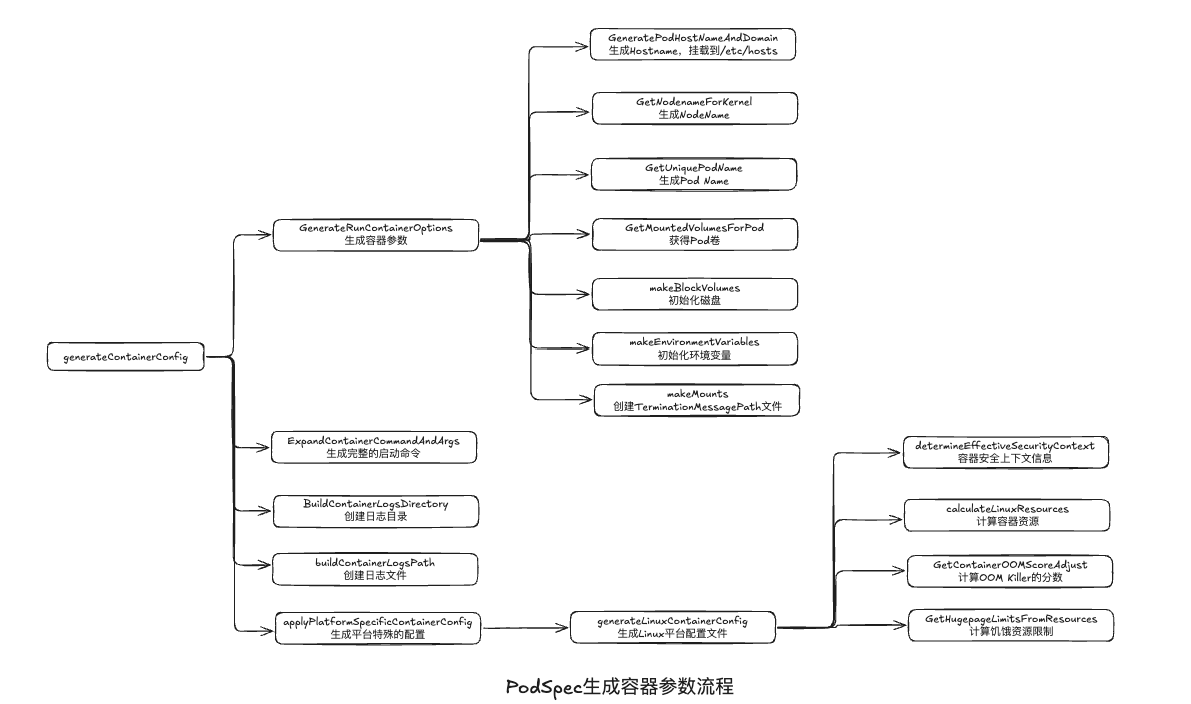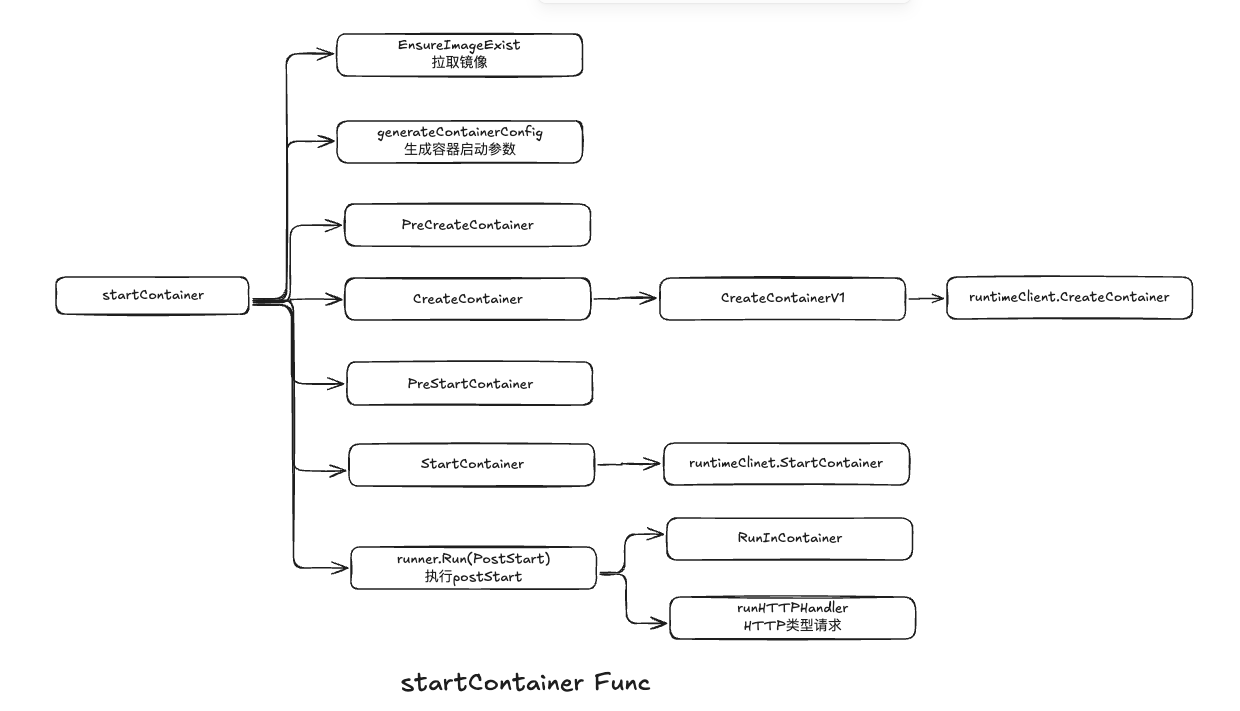1
2
3
4
5
6
7
8
9
10
11
12
13
14
15
16
17
18
19
20
21
22
23
24
25
26
27
28
29
30
31
32
33
34
35
36
37
38
39
40
41
42
43
44
45
46
47
48
49
50
51
52
53
54
55
56
57
58
59
60
61
62
63
64
65
66
67
68
69
70
71
72
73
74
75
76
77
78
79
80
81
82
83
84
85
86
87
88
89
90
91
92
93
94
95
96
97
98
99
100
101
102
103
104
105
106
107
108
109
110
111
112
113
114
115
116
117
118
119
120
121
122
123
124
125
126
127
128
129
130
131
132
133
134
135
136
137
138
139
140
141
142
143
144
145
146
147
148
149
150
151
152
153
154
155
156
157
158
159
160
161
162
163
164
165
166
167
168
169
170
171
172
173
174
175
176
177
178
179
180
181
182
183
184
185
186
187
188
189
190
191
192
193
194
195
196
197
198
199
200
201
202
203
204
205
206
207
208
209
210
211
212
213
214
215
216
217
218
219
220
221
222
223
224
225
226
227
228
229
230
231
232
233
234
235
236
237
238
239
|
func (m *kubeGenericRuntimeManager) SyncPod(pod *v1.Pod, podStatus *kubecontainer.PodStatus, pullSecrets []v1.Secret, backOff *flowcontrol.Backoff) (result kubecontainer.PodSyncResult) {
podContainerChanges := m.computePodActions(pod, podStatus)
klog.V(3).InfoS("computePodActions got for pod", "podActions", podContainerChanges, "pod", klog.KObj(pod))
if podContainerChanges.CreateSandbox {
ref, err := ref.GetReference(legacyscheme.Scheme, pod)
if err != nil {
klog.ErrorS(err, "Couldn't make a ref to pod", "pod", klog.KObj(pod))
}
if podContainerChanges.SandboxID != "" {
m.recorder.Eventf(ref, v1.EventTypeNormal, events.SandboxChanged, "Pod sandbox changed, it will be killed and re-created.")
} else {
klog.V(4).InfoS("SyncPod received new pod, will create a sandbox for it", "pod", klog.KObj(pod))
}
}
if podContainerChanges.KillPod {
if podContainerChanges.CreateSandbox {
klog.V(4).InfoS("Stopping PodSandbox for pod, will start new one", "pod", klog.KObj(pod))
} else {
klog.V(4).InfoS("Stopping PodSandbox for pod, because all other containers are dead", "pod", klog.KObj(pod))
}
killResult := m.killPodWithSyncResult(pod, kubecontainer.ConvertPodStatusToRunningPod(m.runtimeName, podStatus), nil)
result.AddPodSyncResult(killResult)
if killResult.Error() != nil {
klog.ErrorS(killResult.Error(), "killPodWithSyncResult failed")
return
}
if podContainerChanges.CreateSandbox {
m.purgeInitContainers(pod, podStatus)
}
} else {
for containerID, containerInfo := range podContainerChanges.ContainersToKill {
klog.V(3).InfoS("Killing unwanted container for pod", "containerName", containerInfo.name, "containerID", containerID, "pod", klog.KObj(pod))
killContainerResult := kubecontainer.NewSyncResult(kubecontainer.KillContainer, containerInfo.name)
result.AddSyncResult(killContainerResult)
if err := m.killContainer(pod, containerID, containerInfo.name, containerInfo.message, containerInfo.reason, nil); err != nil {
killContainerResult.Fail(kubecontainer.ErrKillContainer, err.Error())
klog.ErrorS(err, "killContainer for pod failed", "containerName", containerInfo.name, "containerID", containerID, "pod", klog.KObj(pod))
return
}
}
}
m.pruneInitContainersBeforeStart(pod, podStatus)
var podIPs []string
if podStatus != nil {
podIPs = podStatus.IPs
}
podSandboxID := podContainerChanges.SandboxID
if podContainerChanges.CreateSandbox {
var msg string
var err error
klog.V(4).InfoS("Creating PodSandbox for pod", "pod", klog.KObj(pod))
metrics.StartedPodsTotal.Inc()
createSandboxResult := kubecontainer.NewSyncResult(kubecontainer.CreatePodSandbox, format.Pod(pod))
result.AddSyncResult(createSandboxResult)
sysctl.ConvertPodSysctlsVariableToDotsSeparator(pod.Spec.SecurityContext)
podSandboxID, msg, err = m.createPodSandbox(pod, podContainerChanges.Attempt)
if err != nil {
if m.podStateProvider.IsPodTerminationRequested(pod.UID) {
klog.V(4).InfoS("Pod was deleted and sandbox failed to be created", "pod", klog.KObj(pod), "podUID", pod.UID)
return
}
metrics.StartedPodsErrorsTotal.Inc()
createSandboxResult.Fail(kubecontainer.ErrCreatePodSandbox, msg)
klog.ErrorS(err, "CreatePodSandbox for pod failed", "pod", klog.KObj(pod))
ref, referr := ref.GetReference(legacyscheme.Scheme, pod)
if referr != nil {
klog.ErrorS(referr, "Couldn't make a ref to pod", "pod", klog.KObj(pod))
}
m.recorder.Eventf(ref, v1.EventTypeWarning, events.FailedCreatePodSandBox, "Failed to create pod sandbox: %v", err)
return
}
klog.V(4).InfoS("Created PodSandbox for pod", "podSandboxID", podSandboxID, "pod", klog.KObj(pod))
resp, err := m.runtimeService.PodSandboxStatus(podSandboxID, false)
if err != nil {
ref, referr := ref.GetReference(legacyscheme.Scheme, pod)
if referr != nil {
klog.ErrorS(referr, "Couldn't make a ref to pod", "pod", klog.KObj(pod))
}
m.recorder.Eventf(ref, v1.EventTypeWarning, events.FailedStatusPodSandBox, "Unable to get pod sandbox status: %v", err)
klog.ErrorS(err, "Failed to get pod sandbox status; Skipping pod", "pod", klog.KObj(pod))
result.Fail(err)
return
}
if resp.GetStatus() == nil {
result.Fail(errors.New("pod sandbox status is nil"))
return
}
if !kubecontainer.IsHostNetworkPod(pod) {
podIPs = m.determinePodSandboxIPs(pod.Namespace, pod.Name, resp.GetStatus())
klog.V(4).InfoS("Determined the ip for pod after sandbox changed", "IPs", podIPs, "pod", klog.KObj(pod))
}
}
podIP := ""
if len(podIPs) != 0 {
podIP = podIPs[0]
}
configPodSandboxResult := kubecontainer.NewSyncResult(kubecontainer.ConfigPodSandbox, podSandboxID)
result.AddSyncResult(configPodSandboxResult)
podSandboxConfig, err := m.generatePodSandboxConfig(pod, podContainerChanges.Attempt)
if err != nil {
message := fmt.Sprintf("GeneratePodSandboxConfig for pod %q failed: %v", format.Pod(pod), err)
klog.ErrorS(err, "GeneratePodSandboxConfig for pod failed", "pod", klog.KObj(pod))
configPodSandboxResult.Fail(kubecontainer.ErrConfigPodSandbox, message)
return
}
start := func(typeName, metricLabel string, spec *startSpec) error {
startContainerResult := kubecontainer.NewSyncResult(kubecontainer.StartContainer, spec.container.Name)
result.AddSyncResult(startContainerResult)
isInBackOff, msg, err := m.doBackOff(pod, spec.container, podStatus, backOff)
if isInBackOff {
startContainerResult.Fail(err, msg)
klog.V(4).InfoS("Backing Off restarting container in pod", "containerType", typeName, "container", spec.container, "pod", klog.KObj(pod))
return err
}
metrics.StartedContainersTotal.WithLabelValues(metricLabel).Inc()
if sc.HasWindowsHostProcessRequest(pod, spec.container) {
metrics.StartedHostProcessContainersTotal.WithLabelValues(metricLabel).Inc()
}
klog.V(4).InfoS("Creating container in pod", "containerType", typeName, "container", spec.container, "pod", klog.KObj(pod))
if msg, err := m.startContainer(podSandboxID, podSandboxConfig, spec, pod, podStatus, pullSecrets, podIP, podIPs); err != nil {
metrics.StartedContainersErrorsTotal.WithLabelValues(metricLabel, err.Error()).Inc()
if sc.HasWindowsHostProcessRequest(pod, spec.container) {
metrics.StartedHostProcessContainersErrorsTotal.WithLabelValues(metricLabel, err.Error()).Inc()
}
startContainerResult.Fail(err, msg)
switch {
case err == images.ErrImagePullBackOff:
klog.V(3).InfoS("Container start failed in pod", "containerType", typeName, "container", spec.container, "pod", klog.KObj(pod), "containerMessage", msg, "err", err)
default:
utilruntime.HandleError(fmt.Errorf("%v %+v start failed in pod %v: %v: %s", typeName, spec.container, format.Pod(pod), err, msg))
}
return err
}
return nil
}
for _, idx := range podContainerChanges.EphemeralContainersToStart {
start("ephemeral container", metrics.EphemeralContainer, ephemeralContainerStartSpec(&pod.Spec.EphemeralContainers[idx]))
}
if container := podContainerChanges.NextInitContainerToStart; container != nil {
if err := start("init container", metrics.InitContainer, containerStartSpec(container)); err != nil {
return
}
klog.V(4).InfoS("Completed init container for pod", "containerName", container.Name, "pod", klog.KObj(pod))
}
for _, idx := range podContainerChanges.ContainersToStart {
start("container", metrics.Container, containerStartSpec(&pod.Spec.Containers[idx]))
}
return
}
|

